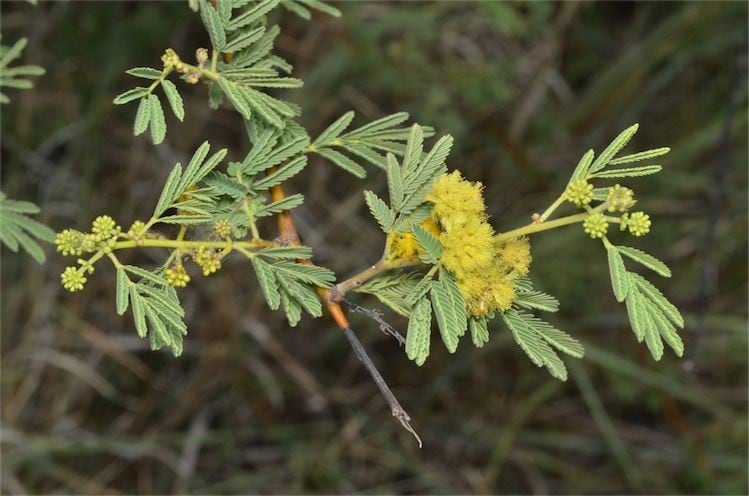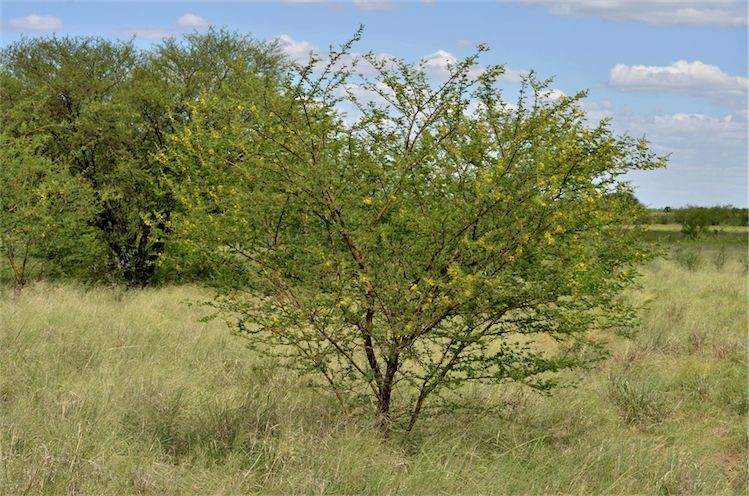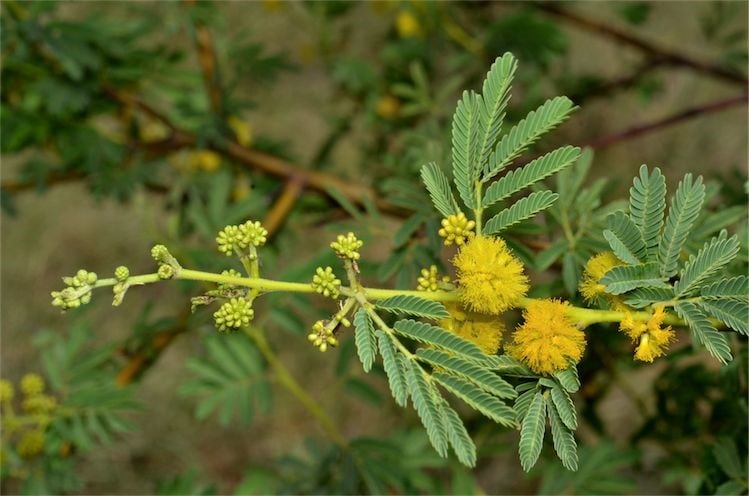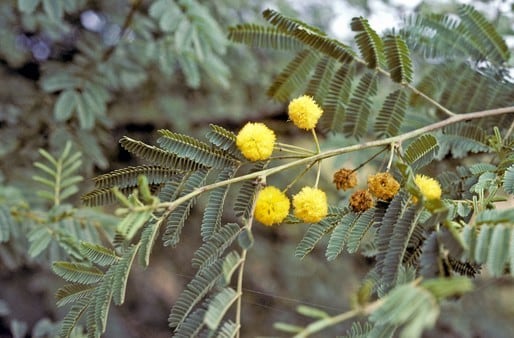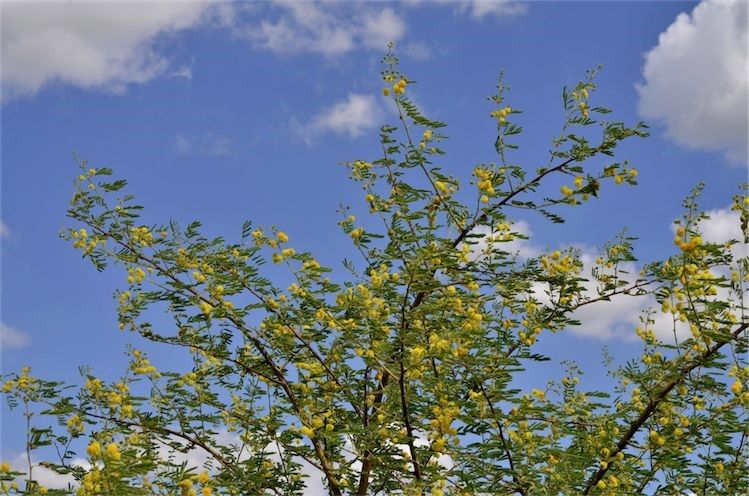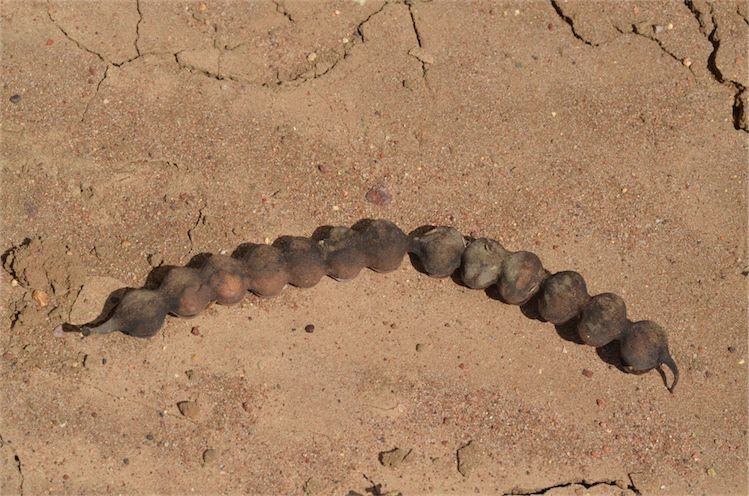Vachellia nilotica subsp. indica (Benth.) Kyal. & Boatwr.
WATTLE
Acacias of Australia
Common Name
Prickly Acacia, Babul
Family
Fabaceae
Distribution
Native of India but naturalised in tropical Qld from Bowen and Hughenden S to Rockhampton and Barcaldine, and to a lesser extent in northern W.A. (near Wyndham), N.T. and north-eastern S.A. on Clifton Hills Stn (fide D.J.E.Whibley & D.E.Symon, Acacias S. Australia 2nd edn 294, 1992). Specimens of cultivated or possibly escaped plants of V. nilotica have been collected from N.S.W., though some are atypical and require further investigation.
Description
Spreading, dense shrub or tree to 12 m high. Bark ±smooth, becoming rough and longitudinally fissured at base. Branchlets sparsely to moderately pubescent especially when young, sometimes glabrous, often slightly pruinose. Stipular spines mostly 2–50 mm long, often diminutive and appearing absent on some branchlets. Leaves: petiole (0.4–) 0.9–2 cm long, pubescent, mostly with a gland at or just below base of lowest pair of pinnae; rachis (0.3–) 0.8–6.8 cm long, pubescent, with a small gland at apex, rarely with a gland at base of second pair of pinnae from apex; pinnae (1–) 2–6 (–10) pairs, 1–4.5 cm long; pinnules 9–30 pairs, narrowly oblong to cultrate or slightly oblanceolate, 1.7–7 mm long, mostly 0.5–2 mm wide, obtuse to broadly rounded at apex, concolorous, with numerous stomata, glabrous or sparsely ciliolate, with midnerve not raised beneath and lateral nerves not visible. Inflorescences simple, 2–6 in axils; peduncles 7–32 mm long, with involucel of bracts mostly 1/2–3/4 way from base; heads globular, 30–53-flowered, yellow to bright yellow. Mature pods narrowly and ±regularly constricted between seeds into ±orbicular sections, flat, 6–25 cm long, 14–17 mm wide (2–4 (–9) mm wide at constrictions), coriaceous, grey- or white-tomentose, sticky inside, indehiscent.
Phenology
Flowers recorded Jan., Apr.–June., Aug.–Sept., probably throughout year; fruits recorded May., Sept. and Oct.
Habitat
May form dense thorny thickets, in grassland, woodland and sometimes open forest, common on cleared land, usually along roadsides and on open plains or floodplains, often near creeks, streams, dams or bores, in silty, heavy (cracking) clay or sometimes sandy alluvial soils.
Specimens
W.A.: Nulla Nulla, 30 km WSW [sphalm. SE] of Wyndham, N.Wilson KNRAg 0404 (MEL n.v., PERTH). N.T.: Darwin, C.E.F.Allen B30 (NSW). Qld: 4 miles [6.4 km] S of Bowen, M.Fagg 681 (CANB, NSW); near Hughendon Township, M.Lazarides 3518 (CANB, NSW, PERTH); 1 mile [1.6 km] NW of Winton, Landsborough Hwy, I.V.Newman 565 (NSW). S.A.: Cordillo Downs HS, W.S.Reid 120 (ADW).
Notes
There are 8 other subspecies of V. nilotica (fide J.H.Ross, Mem. Bot. Surv. S. Africa 44: 106, 1979, as Acacia) but only subsp. indica is currently recognized as adventive in Australia.. However, as discussed by T.J.Wardill et al., J. Biogeography 32: 2145–2159 (2006), there is much genetic diversity among the plants that have been introduced to Australia indicating that more than one infraspecific taxon may be present here.
Vachellia nilotica was formerly the type of Acacia but the genus is now conserved with A. penninervis as the new type, see J.McNeill and N.J.Turland, Taxon 60(5) 1496 (2011). Much has been written about this controversial issue which was most likely finally resolved at the 2011 International Botanical Congress in Melbourne. The opposing views in this debate are best summarized in the following two papers that were published ahead of the Melbourne IBC, G.Moore et al., Taxon 59(4): 1188–1195 (2010) and K.Thiele et al., Taxon 60(1): 194–198 (2011).
Based on molecular and other data Acacia sens. lat. is now considered as comprising a number of segregate genera, see J.T.Miller & D.S.Seigler, Austral. Syst. Bot. 25: 217-224 (2012) for overview. Taxa in the former Acacia subg. Acacia are now referable to the genus Vachellia, including the one presented here.
Description from P.Kodela's treatment of Acacia nilotica subsp. indica.
When its characteristic tomentose, necklace-like pods are not available, specimens of V. nilotica subsp. indica can usually be distinguished from V. farnesiana by its branchlets being ±hairy with less lenticels, and its pinnules without distinct lateral nerves raised beneath.
Initially introduced into Rockhampton, Qld, in the late 1800s as a source of gum arabic, fide R.W.Johnson, Proc. Roy. Soc. Queensland 105: 12 (1995). Subsequently cultivated as an ornamental and grown as a fodder and shade plant, particularly in parts of tropical Qld. Has a high weed potential in pastures. The pods of V. nilotica have been used in tanning and in folklore medicine. Gum exudates and stem bark extracts are also used for medicinal purposes. Notes on habitat, life cycle, origin and distribution, control, etc. are provided by H.E.Kleinschmidt & R.W.Johnson, Weeds of Queensland 196 (1977), A.N.Gracie, Agnote No. 525 (1992) and W.T.Parson & E.G.Cuthbertson, Noxious Weeds of Australia 435 (1992).
FOA Reference
Data derived from Flora of Australia Volumes 11A (2001), 11B (2001) and 12 (1998), products of ABRS, ©Commonwealth of Australia
Author
Adapted from P.G. Kodela, Acacia nilotica subsp. indica (Benth.) Brenan, Flora of Australia 11A: 204–205 (2001). Updated by P.G. Kodela (May 2018).
This identification key and fact sheets are available as a mobile application:
URL: https://apps.lucidcentral.org/wattle/
© Copyright 2018. All rights reserved.
